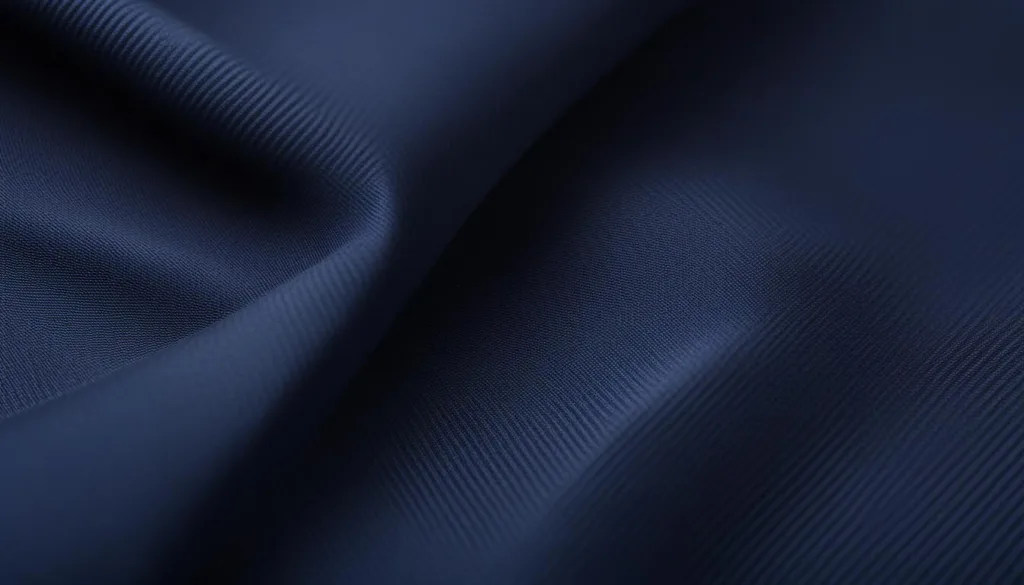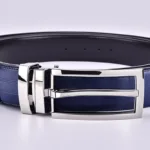Maintaining the sharp look of your navy business suit is essential for projecting a professional image. Over time, these signature pieces of professional attire can lose their impeccable texture and color if not treated with the proper care they require. Whether you’re stewarding an heirloom piece or a modern acquisition, understanding and implementing textile preservation is crucial for any navy business suit.
You need to be aware that different fabrics – from wool to linen, to cotton and synthetics – each have their own specific cleaning and care needs. This is particularly important for vintage suits that may not come with care instructions. Before you begin the cleaning process, engage with a specialist who understands textile preservation. They can advise on the correct cleaning method, preserving the life and look of your suit for years to come.
Understanding Fabric Types in Navy Business Suits

When you’re looking to maintain the classic look of a navy business suit, it’s vital to recognize the fabric which it is constructed of. This knowledge is the cornerstone of fabric-specific care for navy business suits. With a plethora of materials in use, each suit requires a particular type of attention to ensure longevity while preserving its aesthetic appeal.
Identifying Suit Material for Proper Care
Discerning the material of your navy suit is essential for applying the correct care techniques. For those timeless pieces in your wardrobe without a care label, expert consultation is advised. A professional with proficiency in textile conservation can accurately identify fabric types and advise on the best practices for maintaining your navy business suits.
Differences Between Wool, Linen, Cotton, and Synthetic Fibers
Each fabric has intrinsic properties that dictate care procedures. Wool is renowned for its durability, making it a mainstay in both traditional and contemporary business attire. Linen, favored for its breathability, requires different handling to avoid wrinkles and damage. Cotton suits are known for comfort but can be susceptible to shrinkage if not handled properly. Synthetic fibers, on the other hand, offer resilience and ease of care but may respond differently to heat and detergents compared to natural fibers. Understanding these distinctions is key to preserving the condition and appearance of a navy business suit.
| Fabric Type | Characteristics | Recommended Care |
|---|---|---|
| Wool | Durable, Resilient | Dry clean, Avoid high heat |
| Linen | Lightweight, Breathable | Hand wash or dry clean, Iron with care |
| Cotton | Soft, Comfortable | Machine or hand wash, Tumble dry on low |
| Synthetic Fibers | Wrinkle-resistant, Sturdy | Machine wash, Use mild detergent |
Armed with an understanding of fabric types in navy business suits, you’re better equipped to apply fabric-specific care that will enhance the life and appearance of your garments. Whether your suit is a recent acquisition or an heirloom piece, the information above sets the foundation for meticulous care and professionalism in your attire.
Navy Business Suit Fabric Care for Longevity

For professionals dedicated to maintaining the excellence of their navy suits, understanding and implementing key longevity tactics for navy suit fabrics is critical. The caliber of care you provide will contribute substantially to preserving the texture of navy suit fabrics and, by extension, the suit’s overall presentation and longevity.
You may be wondering whether to opt for dry cleaning or safe home washing methods involving a mild detergent. A rule of thumb is that suits made from natural fibers like wool require professional dry cleaning to maintain their shape and texture, while those of lighter materials such as cotton may often be delicately hand-washed. It is of the utmost importance to follow a regimen of regular condition checks, enabling you to discern when professional care becomes a necessity for your suit.
Here are some specific strategies to enhance the longevity of your navy business suit:
- Always inspect your suit after wearing it. Look for any signs of stress or minor damage such as loose threads or missing buttons, and address these issues promptly to avoid further deterioration.
- Invest in quality hangers. Store your suit on a sturdy, well-shaped hanger to maintain its form and structure when not in use.
- Avoid storing your suit in humid or sunlight-exposed areas to prevent fabric degradation.
- In between professional cleanings, use a soft-bristled clothes brush to remove surface dust and particles, a task that can preserve the fabric’s pristine condition.
For additional guidance, consider the following table outlining proper care techniques for various suit fabrics:
| Fabric Type | Cleaning Method | Storage Advice |
|---|---|---|
| Wool | Dry clean only | Use breathable garment bags; avoid plastic |
| Linen | Hand wash or dry clean | Roll rather than fold to prevent creasing |
| Cotton | Gentle wash cycle or hand wash | Store in a cool, dry place; use acid-free paper for folding |
| Synthetic Fibers | Machine washable on a gentle cycle | Allow for air circulation; avoid compressing in storage |
By integrating these care tips and techniques into your routine, you can ensure the enduring appeal and readiness of your essential navy business suits. Elegant, professional attire begets confidence—the cornerstone of a commanding presence in the workplace.
Maintaining Fabric Quality in Navy Suits

As you venture into the world of professional attire maintenance, understanding the nuances of maintaining fabric quality in navy suits is paramount. Such garments not only confer a sense of professionalism but often carry a legacy if they are vintage pieces. Here we delve into handling delicate fabrics and preventing routine damage for both contemporary and heirloom navy suits.
Handling Delicate Fabrics With Care
The impeccable nature of a navy suit starts with the fabric. Delicate fabrics demand your utmost attention and care, revolving significantly around their cleaning and maintenance processes. Eschew abrasive treatings. Instead, tend to your delicate navy suit with the gentle touch and expert care it deserves. For instance, when dealing with heritage naval uniform wool, avoid harsh chemicals and instead seek professional dry-cleaning services that specialize in vintage fabrics.
Preventing Routine Damage and Wear
The longevity of your navy suits is also influenced by their day-to-day treatment. Precluding routine damage involves a proactive approach—regular inspections for wear and tear, prompt mending of any minor issues, and cautious storage. Your diligence in these tasks is instrumental in forestalling fabric deterioration, thus preserving the garment’s integrity for years of wear.
Should your suit encounter the occasional stain or soil, immediate action is key. Remove any adornments, such as medals or ribbons, before cleaning to avoid incidental harm to the fabric. Here are advisable steps to incorporate into your routine:
- Check for loose threads or buttons after each wearing and repair them to prevent further damage.
- Refresh your suit with a soft-bristled brush after outings to lift away dust and particles.
- Ensure proper air circulation when storing, and choose climate-controlled environments away from direct sunlight.
- Rotate your professional attire regularly to evenly distribute wear and prolong fabric quality.
In the quest to safeguard the caliber of your navy suits, this intricate dance of vigilance and preventive care is invaluable. Attentiveness to the condition of your professional attire will pay dividends, fostering an enduringly polished and authoritative presence in your career endeavors.
Seasonal Fabric Care for Navy Suits

As the seasons change, so should your approach to the care and maintenance of your navy suits. To keep your professional attire in impeccable condition, it’s imperative to adapt fabric care methods and employ fabric protection strategies that take into account the climatic variations you’ll encounter throughout the year.
Adapting Care Methods to Weather Conditions
The onset of humid months lays the groundwork for a moisture-rich environment, potentially harmful to your navy suit’s fabric. It’s essential to consider seasonal fabric care for navy suits by ensuring your garments are stored in a dry and cool setting to ward off any moisture-related spoilage. Conversely, during the cold season, attention turns towards protection against pests like moths and the prevention of mold that thrives in dampened, unventilated areas. Both extremes call for vigilance and a tailored approach to suit preservation.
Storage Tips to Preserve Suit Integrity Off-Season
When it comes to off-season storage, strategic methods are key to maintaining the structure and color integrity of your navy suits. Utilize acid-free tissue paper to gently pad your suits and place them in flat, archival-quality boxes designed for textile preservation. Establishing a controlled environment that shuns the extremes of an attic or a basement is crucial. This means finding a space within your home that is consistent in temperature and low in humidity—parameters that are quintessential for fabric protection strategies for navy suits.
- Store navy suits in a dark, cool closet to avoid light exposure and color fading.
- Use suit-specific, padded hangers for short-term storage to maintain shape and structure.
- For long-term preservation, opt for flat storage to reduce stress on the fabric.
- Check the stored condition of your suits periodically to ensure that the protective strategies are effective.
| Season | Care Strategy | Storage Solution |
|---|---|---|
| Spring/Summer | Protect from moisture | Use breathable garment bags and moisture-absorbing products |
| Fall/Winter | Guard against pests and mold | Store in archival-quality boxes with pest deterrents |
| Off-Season | Shield from dust and light exposure | Pad with acid-free tissue; store in a dark, regulated space |
By tailoring your navy suit care routine to suit the changing seasons, you not only ensure a smart professional appearance but also extend the life of your garments. Invest time in these seasonal fabric care practices, and your navy suits will continue to serve you well in all your business endeavors.
Preserving the Texture of Navy Suit Fabrics
Understanding the intricacies of preserving the texture of navy suit fabrics is a vital skill for anyone who values the enduring quality of their professional attire. A navy business suit represents not just a dress code, but a testament to meticulous craftsmanship and style. Adhering to precise navy business suit fabric care practices can significantly prolong the life and elegance of your suits.
-
Choose the Right Cleaner: Seek out a reputable dry cleaner with experience in handling navy suits. Their expertise will be instrumental in maintaining the suit’s texture.
-
Gentle Brushing Technique: Use a soft brush to remove surface dust and debris. This will help preserve the fabric’s natural sheen without causing abrasion.
-
Storage Solutions: Store your suit properly to prevent any creasing or stress on the fabric. Opt for a padded hanger for day-to-day storage.
-
Seasonal Care: Rotate suits based on seasonal wear and have them cleaned before storing for extended periods to avoid settling of any invisible stains that may degrade fabric.
In addition to these practices, an emphasis on proper storage is essential for maintaining your suit’s pristine condition. Below is a table outlining storage strategies tailored to suit care:
| Storage Type | Benefits | Usage |
|---|---|---|
| Padded Hangers | Preserves shape, Allows air circulation | Short-term, Daily use |
| Acid-Free Boxes | Protects from dust and environmental factors | Long-term, Seasonal storage |
| Breathable Garment Bags | Prevents moisture buildup, Offers light protection | Transportation, Temporary storage |
A sound maintenance routine, combined with diligent care measures, will ensure that your navy business suits always look their best, ready to make an impression at any professional gathering. Always remember that investing a little effort into fabric care can result in a significant return on investment in terms of the suit’s longevity and appearance.
Washing and Treatment for Navy Suit Materials
When faced with the decision of cleaning your navy business suit, understanding the nuances between dry-cleaning and handwashing is paramount in providing fabric-specific care for navy business suits. Wool suits, cherished for their elegance and resilience, necessitate the professional touch of dry-cleaning. This method guarantees that the integrity of the fabric is sustained, and the suit remains sharp for each wear. On the other hand, suits crafted from cotton or certain synthetic blends can often endure a gentle handwash with meticulously selected detergents that are tailored for their material composition.
Deciding Between Dry-Cleaning and Handwashing
Your navy suit is more than just an article of clothing; it’s a symbol of professionalism. So, when it comes down to either dry-cleaning or handwashing it, the choice can impact not just the suit’s presentability but also its longevity. Consider dry-cleaning to preserve the impeccable structure and color of materials like wool. For lighter materials, such as cotton and selected synthetics, a soft handwashing with fabric-friendly detergents can cleanse effectively without causing undue stress on the fibers. In either method, handle your suit gently to maintain its esteemed quality.
Specialized Products for Navy Suit Upkeep
Equally crucial is the use of specialized products designed for preserving the luxury of your navy suit. These include precision-formulated stain removers and fabric protectants that work to extend the suit’s lifespan, retaining its pristine condition. Before any treatment, ensure to detach any accessories—medals, ribbons, or pins—to avoid damaging the fabric. Trust these distinguished pieces to experts who will care for them separately with the same attention to detail that your suit requires. By doing so, you stand in good stead to maintain the substance and style of your professional attire for the long term.























